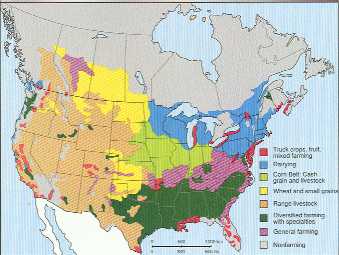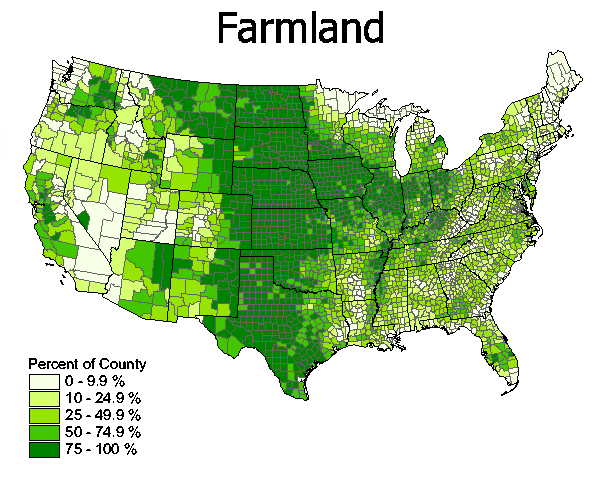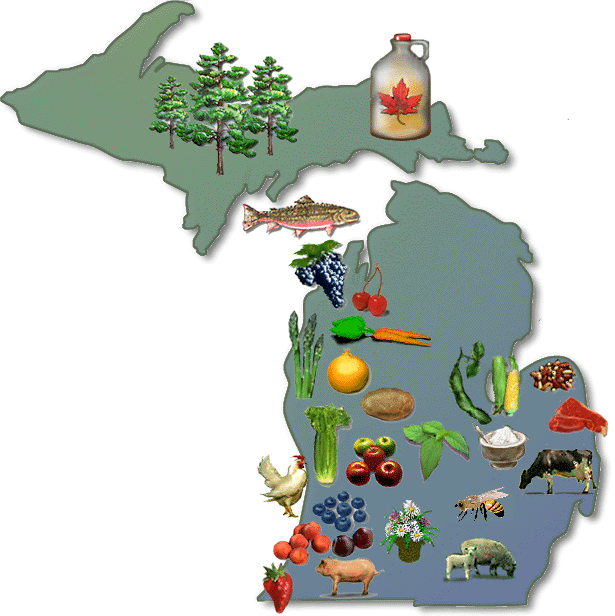Agriculture is the second largest industry in Michigan. Our over 46,000 farms employ more than 100,000 workers and produce over $3.7 billion in commodities each year. Because of our diverse climate (thanks to the Great Lakes), our ag industry is the second most diverse of any state, producing more than 100 food and fiber products.
The average value of farmland in Michigan was $1,470 per acre in 1996, up $141 per acre or 11% from 1995 levels.

Click here for full size image (346 kb)
Source: Unknown
The importance of agriculture to Michigan's people varies widely across the state. In the western UP, little of the land is farmed; most is in forest. Southern lower Michigan, however, lies at the northern end of the corn belt, and up to 80% of some counties are farmed.

Source: Unknown
How do we rank? (data as of
1998)
TOPS in the nation
tart cherries
cranberry beans
black turtle beans
blueberries
cucumbers for pickles
red "new" potatoes
processed (frozen and canned) asparagus
potatoes for chips
Second:
celery
Christmas trees
hanging flower baskets
Easter lilies
all dry beans
navy beans
dark red kidneys
light red kidneys
Third:
apples
fresh asparagus
sweet cherries
fresh carrots
Fourth:
grapes
peaches
Fifth:
sugar beets
plums/prunes
Future problems and opportunities for Michigan agriculture
Having a large urban market near the major agricultural districts tends to ease the
marketing process as well as the reduce transportation costs. Complete self-sufficiency is
unlikely, and is not recommended by agricultural experts, but there are many opportunities
to increase the local production of needed food. Michigan has more marginal land than most
nearby states, and this land could be devoted to agriculture and forests to fulfill more
of the local basic energy, housing, and food needs.
WHAT WE GROW (below)

Source: State of Michigan - Department of Agriculture
There are a number of continuing problems in the future growth of
Michigan’s agriculture. Much of the state has a climate that provides a short growing
season and minimum number of hours of sunlight for plant growth. There are large areas of
wetlands, sandy soils, and hilly topography, which make profitable agriculture difficult,
and large areas of the best farmland have been taken up by urban sprawl. The cash grain
emphasis means that less manure or organic material is being returned to the soil. Large
numbers of part-time farmers are located in the urban south, and they occupy a large
number of acres but have only limited agricultural production. Much vacant or idle land,
held largely for price speculation, is located near many of the urban areas, especially in
the Lower Peninsula.
Thus, Michigan has advantages and disadvantages for additional
agricultural development. There seems little doubt, however, that agriculture will
continue to be one of the major bases of future economic development in the state.
Parts of the text on this page have been modified from L.M. Sommers' book
entitled, "Michigan: A Geography".
This material has been compiled for educational use only, and may not be reproduced without permission. One copy may be printed for personal use. Please contact Randall Schaetzl (soils@msu.edu) for more information or permissions.